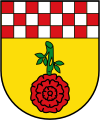Office Blankenstein (Ennepe-Ruhr-Kreis)
The Office Blankenstein was an office in the Bochum district (from 1844 to 1885), in the Hattingen district (from 1885 to 1929) and in the Ennepe-Ruhr district (from 1929 to 1970).

The office was established as Mayor Blankenstein in 1817 as the successor to Mairie Blankenstein in the canton of Hattingen in the arrondissement of Hagen in the Ruhr department of the French-occupied Grand Duchy of Berg . It had its roots in the Brandenburg office of Blankenstein , which has existed since the Middle Ages .
Prussia provisionally administered the Grand Duchy after the French had withdrawn in the Generalgouvernement of Berg before it was finally granted the area at the Congress of Vienna . After the founding of the Province of Westphalia , Prussia introduced its administrative structures. The mayor's office in Blankenstein was assigned to the Bochum district.
In 1844 the mayor's office was converted into an office. To the Office were initially the city Blankenstein and partly of old farming communities emerged rural communities Buchholz , through wood , Heven , Ostherbede , Stiepel , Vormholz and Westherbede . Since 1885 the Blankenstein office belonged to the new Hattingen district , which was separated from the Bochum district. A new official structure was set up in the Hattingen district. Durchholz, Heven, Ostherbede, Vormholz and Westherbede formed the new Heven-Herbede office , while Blankenstein, Buchholz, Holthausen , Stiepel and Welper now formed the Blankenstein office.
In 1929 the Hattingen district was dissolved. At the same time, Stiepel was incorporated into the independent city of Bochum . The Blankenstein office, now consisting of Blankenstein, Buchholz, Holthausen and Welper, became the successor to the Ennepe-Ruhr district.
In 1937 the two communities Obersprockhövel and Niedersprockhövel were incorporated from the dissolved Sprockhövel Office into the Blankenstein Office. On September 1, 1960 Obersprockhövel and Niedersprockhövel were merged to form the municipality of Sprockhövel .
On April 1, 1966, the town of Blankenstein was merged with the municipalities of Buchholz, Holthausen and Welper to form a new town of Blankenstein.
The Blankenstein office was dissolved on January 1, 1970. The town of Blankenstein was incorporated into the town of Hattingen with the exception of the Buchholz district, which was incorporated into Herbede . The municipality of Sprockhövel became an official city.
coat of arms
| Blazon : "In gold (yellow) under a bar in the head of the shield, in three rows of eight fields each, red and silver (white), a fallen red rose with a green stem." | |
| Reasons for the coat of arms: The coat of arms designed by Waldemar Mallek was awarded on December 22, 1956 by the North Rhine-Westphalian Minister of the Interior. It shows the colors of the county of Mark , supplemented by the rose of Count Friedrich von Isenberg , who ruled the area until 1226. In the Treaty of Essen , the Isenberger's heirs had to renounce the area around Hattingen in favor of the Brandenburg count on May 1, 1243. |
Individual evidence
- ↑ Official Journal for the Arnsberg District 1844, p. 103
- ^ Community encyclopedia for the province of Westphalia 1885, offices and communities of the district of Hattingen
- ↑ Law on the municipal reorganization of the Rhenish-Westphalian industrial area of July 29, 1929
- ↑ Stephanie Reekers: The regional development of the districts and communities of Westphalia 1817-1967 . Aschendorff, Münster Westfalen 1977, ISBN 3-402-05875-8 , p. 284 .
- ↑ Law on the amalgamation of the city of Blankenstein and the municipalities of Buchholz, Holthausen and Welper, Ennepe-Ruhr-Kreis
- ↑ Law on the reorganization of the Ennepe-Ruhr district of December 16, 1969
- ↑ Coat of arms of the Blankenstein office
